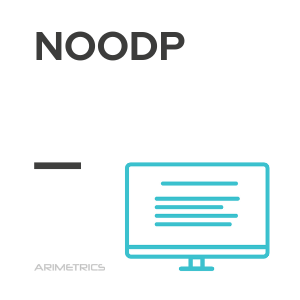 Definition
Definition
NOODP is a meta tag that is used to prevent search engines from using titles and descriptions from the DMOZ directory. This allows you to have more control over how a website is displayed in search results.
Implementation of NOODP
The implementation of the NOODP meta tag requires the insertion of certain tags within the header of the web site’s source code. These tags provide specific instructions to search engine crawlers on how to handle the site’s data. The steps and considerations for proper implementation are described below:
- Meta tag for all crawlers: The following tag is used to instruct all search engines not to use information from the DMOZ directory:
<meta name="robots" content="noodp"/>
This tag is essential for sites that want uniform control over the information displayed in all search engines.
- Microsoft-specific meta tag: To direct instructions exclusively to the Microsoft crawler, the following tag is used:
<meta name="msnbot" content="noodp"/>
This specificity allows site administrators to adjust the interaction with different search engines according to their needs.
- Google-specific meta tag: The following tag is designed for Google crawlers:
<meta name="GoogleBot" content="noodp"/>
Google, being one of the most widely used search engines, may require specific instructions to ensure that it uses the appropriate site information.
- Combination of policies: To allow crawlers to index content and follow links, but not extract titles and descriptions from the DMOZ, the following combination of policies can be used:
<meta name="robots" content="index, follow, noodp"/>
This configuration is useful for sites that wish to maximize their visibility in search engines while maintaining control over the data displayed.
SEO importance of NOODP
The implementation of the NOODP meta tag is critical for SEO for several reasons:
- Control over the content displayed: By using NOODP, you ensure that search engines use the titles and descriptions defined by the site administrator, rather than those that could have been extracted from the DMOZ directory. This is important to maintain consistency of message and branding of the web site.
- Click-Through Rate (CTR) Optimization: A well-written meta title and meta description can significantly increase CTR in search results. By controlling these elements, the site can be more attractive to users.
- Improved positioning: Although meta descriptions do not directly affect ranking, titles do. An optimized title with relevant keywords can improve the site’s position in search results.
- Updating information: Preventing search engines from using DMOZ data ensures that the information presented is the most recent and relevant, which is relevant to maintaining the site’s competitiveness.
- Preventing obsolete content: Since DMOZ is no longer operational, ensuring that search engines do not use obsolete data is vital to the accuracy of the information displayed.
Advantages and considerations of NOODP use
The use of the NOODP meta tag has several significant advantages for the management of a website, as well as some important considerations to be taken into account:
Advantages
- Control over presentation: NOODP allows site administrators to dictate how titles and descriptions are presented in search results, avoiding the use of potentially outdated or inaccurate DMOZ data. This is quite important to maintain brand consistency and ensure that the most relevant content is displayed.
- CTR Optimization: By allowing webmasters to define their own meta titles and descriptions, NOODP contributes to improving the Click-Through Rate (CTR). Well-optimized and engaging content can increase the number of users who select the site’s link in search results.
- Flexibility in search engine management: The ability to specify guidelines for different search engines (such as Google or Microsoft) offers additional flexibility, allowing custom settings based on site-specific needs.
Considerations
- Reliance on DMOZ: Although DMOZ is no longer operational, the NOODP tag is still relevant to ensure that search engines do not use obsolete data. However, its effectiveness depends on how each search engine interprets and applies these guidelines.
- Current relevance: Since the DMOZ directory is no longer updated, it is important for site administrators to review the need for this meta tag in the current SEO context. Although many search engines have stopped relying on DMOZ, the use of NOODP may still be a recommended practice to maintain full control over the submission of site data.
- Compatibility and updates: Administrators should be aware of search engine updates and adjust metatags as necessary. Evolving SEO practices and search technologies may influence the effectiveness of NOODP.
